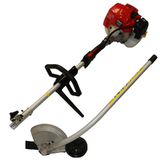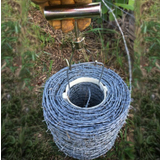When shopping for electric fencing products like polywire, polytape, or polyrope, you’ll often see phrases like “effective up to 1,200m.” But what does that really mean?
The truth is: there’s no fixed number that suits every setup. The actual distance your electric fence can carry a strong pulse depends on several key factors. In this article, we’ll explain the most important ones and help you choose the right gear for your needs.
1. Energiser Output (The Most Important Factor)
Think of your energiser like a battery charger for your fence. The more powerful it is (measured in joules), the further the current can travel down the line — but how far it reaches also depends heavily on the type of wire you're using.
- Low-output energisers (0.4–1 joule): Best suited for short runs using high-resistance materials like polywire or polytape — typically up to 1–2km.
However, when paired with steel wire, which has extremely low resistance, even these smaller energisers can power much longer distances — often 5–8km under good conditions.
- Mid-output energisers (1–4 joules): A solid all-rounder for most rotational grazing setups, hobby farms, or lifestyle blocks using poly products or multi-line fencing.
- High-output energisers (4.5+ joules): Required for long boundary fences, multi-wire systems, or setups running through vegetation that leaks current.
Tip: If you're unsure, size up. An underpowered energiser is the most common cause of weak shocks and ineffective fencing.
2. Resistance of the Fence Material
All fence wires, tapes, and ropes have electrical resistance, measured in Ohms per metre (Ω/m). Higher resistance means the current weakens faster as it travels — which reduces how far your energiser can effectively power the fence.
|
Product Type
|
Typical Resistance
|
Best Use
|
|
Polywire
|
~4.0–6.0 Ω/m
|
Temporary fencing or strip grazing
|
|
Polytape (12mm)
|
~4.0–5.0 Ω/m
|
Short runs, light setups
|
|
Polytape (40mm)
|
~1.5–2.5 Ω/m
|
Horses, visual fencing, strong energiser
|
|
Polyrope
|
~0.2–0.5 Ω/m
|
Long runs, high power, large animals
|
|
Steel Wire
|
~0.05–0.1 Ω/m
|
Permanent fencing, long runs, high efficiency
|
Lower resistance = longer effective distance.
What About Steel Wire?
Steel wire has extremely low resistance — which makes it ideal for long runs and low-loss fencing, even with a smaller energiser.
For example, with a 0.4-joule energiser, you can often power:
- 5–8km of steel wire under typical conditions
- Up to 10–15km in ideal conditions (clean fence, one wire, dry weather)
- As little as 2–4km if there are weeds, multiple wires, or poor earth
This is why many of our customers who use steel wire fencing find even small energisers perform well — as long as grounding and fence condition are up to scratch.
3. Grounding System Quality
Even with a strong energiser, if your earth system is poor, the fence won’t work properly. The energiser needs to complete a circuit through the ground.
Good earthing means:
- 3 or more earth rods, 1–2m long
- Spaced at least 3 metres apart
- Installed in moist soil, not dry or sandy areas
Wet ground = better grounding. Dry soil = poor performance.
4. Weed Load (Vegetation Touching the Fence)
Grass, weeds, or shrubs brushing against the wire leak electricity, draining your energiser. This is especially true with polywire and tape, which carry less current than steel.
If your fence line will grow over or go through bush:
- Use low-resistance materials (like rope or steel)
- Consider a stronger energiser
- Mow or clear along fence lines regularly
5. Number of Fence Lines and Total Wire Length
A 500m straight fence is not the same as 500m of fence with three wires running in parallel. That’s 1,500m of total wire — triple the resistance.
- Each extra wire adds load to your energiser.
- Keep this in mind when calculating how far your power will reach.
6. Quality of Connections and Joins
Bad joins or connectors act like roadblocks for electricity.
- Use stainless steel joiners or crimps, not tied knots.
- Keep all hardware clean and rust-free.
7. Animal Type and Coat Thickness
While this doesn’t affect how far the current travels, it affects how effective the shock is. Animals with thick coats (e.g. woolly sheep, long-haired goats) may not feel weaker pulses.
Tip: For woolly animals or stubborn livestock, a strong energiser is even more important.
Summary: Match the Setup to the Job
Here’s a quick cheat sheet for choosing the right fencing material and energiser combo:
|
Setup Type
|
Material
|
Resistance (Ω/m)
|
Energiser Size
|
Max Run (Guide)
|
|
Small temp paddock
|
Polywire
|
4–6 Ω/m
|
0.4–1J
|
300–500m
|
|
Horse fencing
|
12–40mm Tape
|
2–5 Ω/m
|
1–3J
|
500m–2km
|
|
Long paddocks, sheep/goats
|
Polyrope
|
0.2–0.5 Ω/m
|
1–4J
|
1–4km
|
|
Long boundary fences
|
Steel Wire
|
0.05–0.1 Ω/m
|
4.5+ J
|
5–15km
|
By understanding these key factors — energiser output, material resistance, grounding, and more — you can choose the right electric fence setup for your needs. Whether you're fencing a small paddock or a large boundary, selecting the right materials and energiser combination ensures that your fence operates efficiently and covers the desired distance.
For a complete setup, check out our Electric Fence Starter Kits and Electric Fence Wire and Tape at Chainsaw Spares, where we offer everything you need for your fencing requirements. Our fencing equipment range ensures you have the best materials for efficient and reliable fence performance.
Remember, always account for the specific requirements of your setup, and don’t hesitate to go for a higher-powered energiser if you're unsure. A properly designed and maintained electric fence can protect your property effectively and with minimal hassle.
















